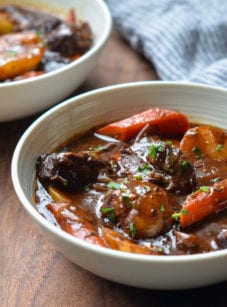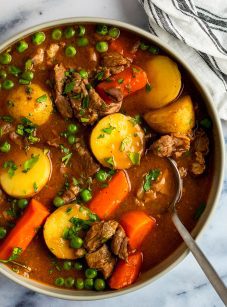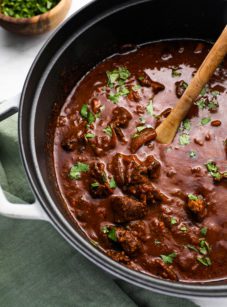Hungarian-Style Goulash
This post may contain affiliate links. Read my full disclosure policy.
With tender beef and a rich broth, Hungarian goulash is a deeply satisfying dish. Serve it over egg noodles with a dollop of sour cream for the ultimate comfort food.

Hungarian goulash has been around for centuries, originally made by Hungarian shepherds as a hearty meal cooked over an open fire. The word “goulash” comes from the Hungarian term “gulyás,” meaning herdsman. While the classic version is more like a soup, this version is thicker and boasts an incredibly rich flavor—similar to beef stew. The secret lies in searing the meat first and thickening the broth with a bit of flour. And let’s not forget Hungarian sweet paprika; it adds that smoky, slightly sweet warmth that’s essential to the dish.
Although it simmers for about three hours, this goulash recipe is mostly hands-off—just set it and forget it, and you’ll be rewarded with the most satisfying meal ever. Serve it over egg noodles or spaetzle, or pair it with crusty artisan bread or popovers, and don’t forget a dollop of sour cream for the perfect finishing touch!

Table of Contents
American vs Hungarian Goulash
American and Hungarian goulash are two distinctly different dishes. American goulash is a simple one-pot meal with ground beef, elbow macaroni, and a tomato-based sauce with Italian seasoning. Hungarian goulash, on the other hand, is a soup-like dish made with tender chunks of beef, onions, and vegetables in a paprika-spiced broth. While American goulash is more of a beefy pasta dish, Hungarian goulash is a classic soup or stew, traditionally served with crusty bread or noodles.
This recipe is Hungarian-inspired, with a few liberties taken. Traditional Hungarian goulash typically has a brothy base made with water. Here, I’ve added beef broth, tomato paste, and a touch of balsamic vinegar for extra depth, along with flour for a heartier consistency. It may not be strictly traditional, but it’s a delicious, satisfying take!
What You’ll Need To Make Goulash

- Boneless Beef Chuck: A well-marbled cut, perfect for stews due to its rich fat content. When slow-cooked, it becomes tender and flavorful.
- Vegetable Oil: Used for searing the beef, which caramelizes the exterior and locks in flavor before slow cooking.
- Onions And Garlic: Provide a savory, aromatic base that deepens the flavor as they cook down and meld with the beef.
- Balsamic Vinegar: Not traditional for goulash but adds a slight tang and sweetness, cutting through the richness and balancing the dish.
- Tomato Paste: Concentrated in flavor, it brings a deep, umami-rich base that thickens the sauce and adds complexity.
- All-Purpose Flour: Coats the beef and acts as a thickening agent, helping the goulash achieve its signature hearty texture.
- Beef Broth And Water: Form the liquid base of the goulash.
- Caraway Seeds, Paprika, And Dried Thyme: Traditional Hungarian spices that give the goulash its warm, earthy, and slightly smoky flavor. If you have Hungarian sweet paprika, I recommend using it.
- Bay Leaf: Infuses the dish with subtle herbal notes.
- Sugar: Balances the acidity from the vinegar and tomato paste, adding a very subtle touch of sweetness.
- Carrots And Boiling Potatoes: Vegetables that add heartiness and texture, making the goulash more substantial.
- Jump to the printable recipe for precise measurements
Step-By-Step Instructions
Pat the beef dry and season with the salt and pepper. In a large Dutch oven or heavy soup pot, heat 1 tablespoon of the oil over medium-high heat until hot and shimmering. Brown half the meat in a single layer, turning with tongs, for about 5 minutes. Repeat with the remaining oil and beef. (To sear the meat properly, do not crowd the pan and let the meat develop a nice brown crust before turning with tongs.) Transfer the meat to a large plate and set aside.

Add the onions, garlic, and balsamic vinegar; cook, stirring with a wooden spoon and scraping the brown bits from the bottom of the pan, for about 5 minutes.

Stir in the tomato paste.

Add the beef with its juices back to the pan and sprinkle with the flour. Stir with a wooden spoon until the flour is dissolved, about 1 minute.

Add the broth, water, caraway seeds, paprika, thyme, bay leaf, and sugar.

Stir with a wooden spoon to loosen any brown bits from the bottom of the pan and bring to a boil. Reduce the heat to low, cover the pot with a lid, and simmer for 2 hours, stirring occasionally.

Add the carrots and potatoes (if using) and cook, covered, for 1 hour more, until the broth is thickened, and the meat and veggies are tender.

Fish out the bay leaf and discard, then taste and adjust seasoning, if necessary. Serve the goulash, or let it come to room temperature, and then store in the refrigerator overnight or until ready to serve.

Garnish with fresh parsley and top with a dollop of sour cream, if desired.

Make-Ahead & Freezing Instructions
Goulash can be made up to 3 days ahead of time. Reheat on the stovetop over medium heat until warmed through. It can also be frozen for up to 3 months. Before serving, defrost the stew in the refrigerator for 24 hours and then reheat on the stovetop over medium heat until warmed through.
Video Tutorial
You May Also Like
Goulash
Ingredients
- 3 lbs boneless beef chuck, cut into 1½-inch (3.75-cm) pieces
- 2 teaspoons salt
- ¾ teaspoon freshly ground black pepper
- 2 tablespoons vegetable oil
- 2 medium yellow onions, thinly sliced
- 4 cloves garlic, roughly chopped
- 2 tablespoons balsamic vinegar
- 3 tablespoons tomato paste
- ¼ cup all-purpose flour
- 3 cups beef broth
- 2 cups water
- 1½ teaspoons caraway seeds
- 2 tablespoons paprika (preferably Hungarian sweet paprika)
- 1 teaspoon dried thyme
- 1 bay leaf
- 1½ teaspoons sugar
- 3 carrots, peeled and cut into 1-inch chunks on the diagonal
- 1 pound small white boiling potatoes (baby Yukon Gold) cut in half (optional, if not serving over noodles)
For Serving (Optional)
- Chopped fresh parsley
- Sour cream
Instructions
- Pat the beef dry and season with the salt and pepper. In a large Dutch oven or heavy soup pot, heat 1 tablespoon of the oil over medium-high heat until hot and shimmering. Brown half the meat in a single layer, turning with tongs, for about 5 minutes. Repeat with the remaining oil and beef. (To sear the meat properly, do not crowd the pan and let the meat develop a nice brown crust before turning with tongs.) Transfer the meat to a large plate and set aside.
- Add the onions, garlic, and balsamic vinegar; cook, stirring with a wooden spoon and scraping the brown bits from the bottom of the pan, for about 5 minutes. Stir in the tomato paste. Add the beef with its juices back to the pan and sprinkle with the flour. Stir with a wooden spoon until the flour is dissolved, about 1 minute. Add the broth, water, caraway seeds, paprika, thyme, bay leaf, and sugar. Stir with a wooden spoon to loosen any brown bits from the bottom of the pan, and bring to a boil. Reduce the heat to low, cover the pot with a lid, and simmer for 2 hours, stirring occasionally.
- Add the carrots and potatoes (if using) and cook, covered, for 1 hour more, until the broth is thickened, and the meat and veggies are tender. Fish out the bay leaf and discard, then taste and adjust seasoning, if necessary. Serve the goulash, garnished with fresh parsley and a dollop of sour cream, if desired. If not serving immediately, let it come to room temperature, and then store in the refrigerator until ready to serve.
Notes
Nutrition Information
This website is written and produced for informational purposes only. I am not a certified nutritionist and the nutritional data on this site has not been evaluated or approved by a nutritionist or the Food and Drug Administration. Nutritional information is offered as a courtesy and should not be construed as a guarantee. The data is calculated through an online nutritional calculator, Edamam.com. Although I do my best to provide accurate nutritional information, these figures should be considered estimates only. Varying factors such as product types or brands purchased, natural fluctuations in fresh produce, and the way ingredients are processed change the effective nutritional information in any given recipe. Furthermore, different online calculators provide different results depending on their own nutrition fact sources and algorithms. To obtain the most accurate nutritional information in a given recipe, you should calculate the nutritional information with the actual ingredients used in your recipe, using your preferred nutrition calculator.






I made this recipe and it was delicious! I didn’t have caraway seeds so used fennel seeds instead and it turned out great! We liked it so much. I plan to make it again for company next week.
Your Hungarian Goulash recipe was an absolute winner in taste, texture and looks. My guests raved about it.
Thank you very much.
Great tasting Goulash ! Worth the time and effort. I did not have Hungarian Paprika but still came out tasy using regular paprika. Is ther a particular brand or kind of paprika you would recommend. Love your recipes.
So glad you enjoyed it, Lynn! I use Pride of Szeged Sweet Paprika Powder – you can find it in many grocery stores or order it on Amazon.
Yay! I’m the first to comment having made this dish tonight! And it was delicious. It has a rich unique flavour and the beef was tender. A perfect meal for the colder weather. Yum!! Glad I made it!!!! Followed the beef stew method by putting it in the oven at 325 f for 2 hours then 1 hour after adding the carrots. Excellent recipe!
This goulash takes a bit more work than my usual recipe, but it’s so much better and totally worth it. The broth is rich and incredibly tasty.
I’ve never used caraway seeds before and am a bit concerned about the texture. Will they be softened by the end or still kinda crunchy? Assuming they’re crunchy to begin with; I really don’t know anything about them.
Would putting them in a tea strainer or cheesecloth work? Doing so should let the flavor infuse the goulash without having a weird texture, right?
Hi Kallisti, the caraway seeds still have a bit of a bite at the end of cooking time. What you’ve suggested about straining them would work nicely. It’s also OK to omit them if you’d prefer. Please LMK how it turns out!
Hi Jenn, Can we stick this in the oven at 325 or 350 for two hours and then an other hour after we add the potatoes–to avoid having to babysit it on the stove top? Similar to your beef stew? Hoping so but figured there must be a reason you didn’t say this? Thanks for any thoughts.
Hi Diane, yes, it’s fine too braise the goulash in a 325°F oven as you would the beef stew. (Either technique will work for either recipe.) Hope you enjoy!
Hi Jenn! This looks delicious. Can’t wait to try it. I don’t have caraway seeds — any chance I can use fennel (or something else)?
Sure, Nadine – fennel seeds will work or you can just omit it.
Hi Jen,
Sounds delicious and I plan to make it.
Can this be done in a slow cooker instead of on the stove top?
Hi Jan, Yes, you can make it in a slow cooker — you’ll need to go all through all the steps until you’re ready to add the water and broth. At that point, you add everything to the slow cooker and cook for 4 – 5 hours on high (and you can put the carrots and the potatoes in with the meat– you don’t need to wait). Please LMK how it turns out!
Thanks, Jenn,
I will try it the stove top way first.
Jan
How can I adapt this recipe for slow cooker.
Hi Elizabeth, You can make it in a slow cooker — you’ll need to go all through all the steps until you’re ready to add the water and broth. At that point, you add everything to the slow cooker and cook for 4 – 5 hours on high (and you can put the carrots and the potatoes in with the meat– you don’t need to wait). Please LMK how it turns out!